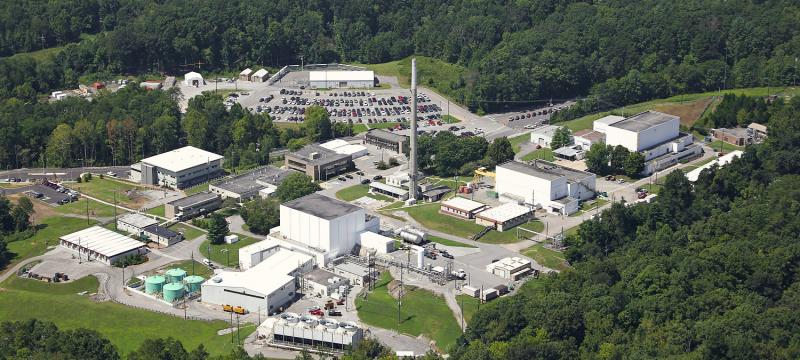
The High Flux Isotope Reactor at Oak Ridge National Laboratory. (Photo courtesy U.S. Department of Energy/ORNL)
Federal laboratories in Oak Ridge and Idaho, along with a nuclear research center in Belgium, will make their research reactors, labs, and education and training facilities available to scientists from other countries for training, research, and development, officials announced at the IAEA General Conference in Austria on Monday.
The IAEA is the International Atomic Energy Agency.
The facilities that will make their reactors available are the U.S. Department of Energy’s Oak Ridge National Laboratory and Idaho National Laboratory, and the Belgian Nuclear Research Centre SCK*CEN, the IAEA said.
The institutions received designations as IAEA International Centres based on Research Reactor, or ICERR, the IAEA said.
The reactors include the High Flux Isotope Reactor at ORNL, the Advance Test Reactor at Idaho National Laboratory, and the Belgian Reactor 2.
“The IAEA ICERR scheme helps IAEA member states access state-of-the-art facilities and so achieve their national nuclear research and development and capacity building objectives,” IAEA Director General Yukiya Amano said at Monday’s designation ceremony. “Through advanced training, ICERRs foster knowledge, build nuclear competence, and develop nuclear safety culture.”
The IAEA said the High Flux Isotope Reactor at ORNL is the world’s leading source of heavy elements used for research, medicine, and industrial applications. The High Flux Isotope Reactor and its associated nuclear facilities provide unique capabilities only available through DOE for post-irradiation testing of materials and processing of radioisotopes.
The U.S. Department of Energy said ORNL is a global leader for the production of many important isotopes, including plutonium-238, which fuels NASA’s deep space exploration efforts; californium-252, which is used for real-time sulfur analysis in the power industry; nickel-63, which is used in explosive detectors at airports; radium-223, which aids palliative treatment for metastatic cancer; and berkelium-249, which recently enabled the discovery of tennessine, element 117.
“The nuclear research facilities at ORNL are vital to scientific research, nuclear security, and nuclear nonproliferation,” ORNL Director Thomas Zacharia said. “Our capabilities are further enhanced by numerous partnerships with industry, academia, and other premier research facilities like INL.”
The IAEA said the Advance Test Reactor at Idaho National Laboratory is the most versatile test reactor in the world. It is used to study the effects of radiation on materials and is also capable of producing rare and valuable medical and industrial isotopes.
DOE said INL’s Advanced Test Reactor (ATR), Transient Reactor Experiment and Test (TREAT) reactor, nuclear fuel fabrication facilities, and nuclear facilities for post-irradiation examination (PIE) of nuclear fuels and materials provide unmatched capabilities, all in one geographic location.
“This new opportunity to facilitate the expanded use of our national labs’ research reactor facilities will enable the United States to continue to be a world leader and global partner in the peaceful use of nuclear science and technology,” said Rick Perry, U.S. energy secretary. “This is a tremendous honor recognizing the critical work being conducted at DOE’s Oak Ridge and Idaho national laboratories, and it highlights the importance of our nuclear research facilities and the scientific and nuclear security contributions they bring to the world.”
The Belgian research reactor BR2 (Belgian Reactor 2) is one of the most powerful and flexible research reactors in the world. It produces 20 to 25 percent of the world’s most important radioisotopes, including medical isotopes essential for the diagnosis and treatment of cancer.
“This is an outstanding recognition for Belgium,” said Eric van Walle, director general of SCK•CEN. “The nuclear expertise and experience obtained through our research and development support the education and training activities with which we transfer knowledge and skills to current and future generations. We are proud to contribute to IAEA’s goal with our unique infrastructure.”
The Belgian SCK•CEN and US Department of Energy’s Idaho and Oak Ridge National Labs join France’s CEA and the Russian Federation’s RIAR centers in welcoming researchers under the IAEA scheme, the IAEA said.
The ICERR scheme was launched in 2014 to help member states, mainly without research reactors, gain timely access to research reactor infrastructure and carry out nuclear research and development as well as build capacity, the IAEA said. Member states that want to gain access to an ICERR have to become an affiliate by signing a bilateral agreement with the centers designated as ICERR. The IAEA facilitates this process, also through the sharing of the information on the capabilities offered by the ICERRs, the agency said.
The IAEA is a 168-member international organization that includes the United States. With headquarters in Vienna, it is the world’s central intergovernmental forum for scientific and technical cooperation in the nuclear field. It works for safe, secure, and peaceful uses of nuclear science and technology.
Here is more information from DOE about HFIR (High Flux Isotope Reactor) at ORNL and ATR (Advanced Test Reactor) at INL:
HFIR—Operating at 85 megawatts, HFIR is the highest flux reactor-based source of neutrons in the United States, and it provides one of the highest steady-state neutron fluxes in the world. Every year, more than 500 researchers use its thermal and cold neutrons to perform neutron scattering experiments, in the study of physics, chemistry, materials, engineering, biology, and nuclear forensics. Recent research results are helping to develop better drugs for diseases such as HIV, improving the efficiency and durability of 3D-printed rocket parts, and improving the safety and efficiency of batteries in cell phones and cars. HFIR, coupled with ORNL’s hot cell and other nuclear facilities, enables a diverse range of nuclear science and technology research, from examining materials for next-generation reactors to developing new types of nuclear fuel.
ATR—The ATR can operate at up to 250 megawatts, and it also provides a steady-state neutron flux for numerous researchers all at the same time. There are 77 test locations within the core and beryllium reflector of the reactor, including six locations that replicate physical conditions—temperature, pressure, chemistry and flow—of various power plants. Nine of the 77 locations are referred to as “flux traps” due to their positions near the fuel, and experiments can be from one-half inch to five inches in diameter and up to four feet long. ATR simultaneously provides irradiation of nuclear fuels, materials and isotopes for the U.S. Navy, DOE research programs, industry, universities, and international customers.
In addition to the steady-state capabilities of ATR, the TREAT reactor will soon provide researchers the ability to test current and new nuclear fuel designs in off-normal reactor conditions. The TREAT will provide very brief, very intense power surges, replicating severe accident conditions. In less than one second, fuels can be exposed to up to 18,000 megawatts thermal energy.
INL has the capability to fabricate nuclear fuel or materials specimens, irradiate them in steady-state or transient conditions, and perform PIE on the experiments in the largest inert hot cell in the United States. Capabilities are being brought online to provide unprecedented examinations of irradiated materials, providing researchers across the nation and around the world even greater understanding of the processes in nuclear reactions, fuels, and materials.
INL is the nation’s lead laboratory for nuclear research as well as leading DOE’s Nuclear Science User Facility, providing access to nuclear research capabilities at national laboratories, universities, and industry facilities.
More information will be added as it becomes available.
See the DOE press release here.
See the IAEA press release here.
Do you appreciate this story or our work in general? If so, please consider a monthly subscription to Oak Ridge Today. See our Subscribe page here. Thank you for reading Oak Ridge Today.
Copyright 2017 Oak Ridge Today. All rights reserved. This material may not be published, broadcast, rewritten, or redistributed.

Leave a Reply